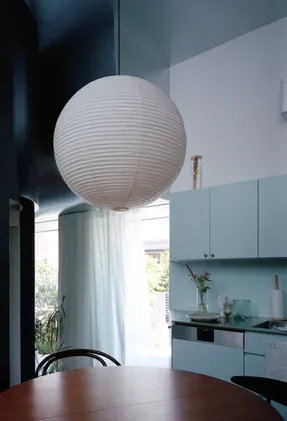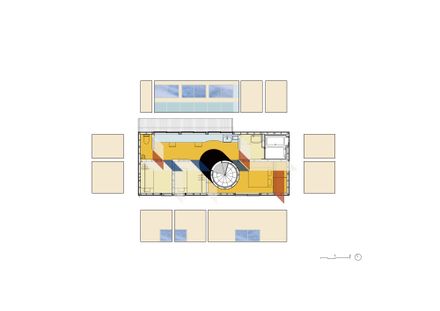
House of After Image
ARCHITECTS
Ultra Studio
LEAD ARCHITECTS
Yuji Mukaiyama, Yushi Sasada, Alyssa Ueno
DESIGN TEAM
Akito Ikeda
LANDSCAPE ARCHITECTURE
Oryza / Shunro Fujiwara, Ryo Nishioka
ENGINEERING & CONSULTING > STRUCTURAL
Arstr / Yohei Tomioka
YEAR
2023
LOCATION
Japan
CATEGORY
Houses
Text description provided by architect.
This is a house for a young couple and their child, built in a typical Tokyo residential neighborhood in Tokyo. The site faces a relatively busy front street on the east side and a narrow alley less than two meters wide on the other.
While the street side lacks any features, the alley side has a more intimate atmosphere created by neighboring houses cultivating gardens and plants. Therefore, the "facade" of the house was shifted toward the alley, where a garden and window were added to contribute to this atmosphere.
The front, stripped of its facade, presents a quiet exterior that conceals the internal layout. Inside, the ceiling on the second floor was kept low, while the first floor was given a ceiling height of about four meters, creating a sense of vertical expansion within the limited floor area.
In contrast to the expressionless exterior, the interior is defined by a symbolic black cylinder that divides the space.
Around this black cylinder are various decorative elements, each with different origins. For instance, a silver horizontal cylinder above the window facing the alley serves both as a reflective surface to diffuse light from the high window and the garden view, and as a space for piping.
A mirror affixed to a blue column allows someone in the kitchen to observe the living room. Elements on the north side, such as the kitchen and the cylinder, are mirrored and transposed onto the interior south wall as painted forms.
Meanwhile, on the upper floor, divided into small rooms, the black cylinder appears in each, indicating their relative positions.
When sliding doors are opened, the cylinder connects the spaces, generating a sense of rotational movement.
Additionally, color is scattered throughout the house as decorative elements. Illuminated by different lights over time, the house reveals a fresh appearance depending on the time and place.
Amid all this, the black cylinder always appears as an "unseen area" within one's field of vision.
This decorated space, only partially perceived due to the visual void created by the black cylinder, generates an infinite series of fragmented images as the perspective shifts.
Meanwhile, through daily life, these images accumulate in the mind, making the residents' perception of the space increasingly concrete, while the black cylinder gradually fades from consciousness.
The symbolic nature of the architecture recedes behind the cluster of fragmented images. It is perhaps at this point that the cylinder becomes part of the identity of the house and its residents.
Just as people do not consciously notice their own nose within their field of vision, the residents, too, may one day come to see this black cylinder as transparent.
























